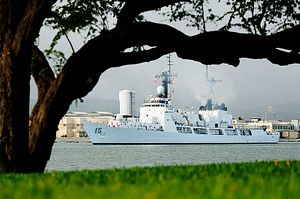Earlier this week, the Philippines Armed Forces confirmed that BRP Gregorio del Pilar (FF-15), a Hamilton-class cutter transferred by the United States in 2011 to the Philippine Navy, had run aground in the South China Sea. The vessel hit shallow waters off the partially submerged Half Moon Shoal (also known as Hasa-Hasa Shoal) off Palawan Island. The waters where the vessel ran aground are disputed by other South China Sea claimant states, notably including China.
Col. Noel Detoyato, a spokesperson for the Philippine Armed Forces, confirmed that the vessel had run aground, noting that there were no casualties from the accident. A Philippine military report cited in local news reports noted that the Gregorio del Pilar was “grounded from bow to amidship and propellers were also damaged.”
“The crew inspected all spaces and there were no noted flooding,” it added. “An investigation is expected in such situations to find out the possible causes of the grounding and to come up with steps to ensure that similar incidents will be prevented,” Detoyato added.
Named for the Filipino revolutionary general, the 3,250 ton BRP Gregorio del Pilar is the flagship of the Philippine Navy. The vessel was decommissioned by the U.S. Coast Guard in March 2011 and the Philippine Navy took delivery later that year. The ship was commissioned after a minor period of refurbishment in December 2011.
According to the Philippine Armed Forces, the vessel ran aground during a routine patrol, underlining the navigational challenges that persist in the shallow disputed shoals in the Spratly Islands. Half Moon Shoal was the location where a Chinese People’s Liberation Army-Navy frigate ran aground in 2012 on a routine patrol.
The incident could present new challenges for the Philippines, which has sought to assert its claims in the Spratly Islands. In 2016, a Hague-based arbitral tribunal presented its award in a case originally filed by Manila in 2013 after China’s seizure of Scarborough Shoal.
The tribunal ruled almost completely in favor of the Philippines’ submissions on maritime entitlements and pushed back on China’s capacious nine-dashed line claim. Despite the award, China has increased its presence in the Spratlys, where it has constructed seven artificial islands.
Moreover, the relationship between Beijing and Manila changed dramatically beginning in late-2016, after President Rodrigo Duterte took office in the Philippines. All of this presents a possible opening for China to come to the assistance of the Philippine vessel—a maneuver that would underline its de facto administrative presence in this part of the South China Sea.
As the Asia Maritime Transparency Initiative’s Gregory Poling noted on Twitter, China has done this before: “It closed Jackson Atoll in 2016 to remove a stranded foreign vessel. This would be another matter entirely, but not sure its out of the question.”
The Philippine presidential palace on Friday issued a statement pushing back on the notion that China would assist. Retrieval operations were underway “with no problems from China,” said Harry Roque, a spokesperson for the Philippine presidential office.
The recovery operation happens to coincide with a separate U.S. Navy-Japanese Maritime Self-Defense Force bilateral exercises in the South China Sea. The exercise involves the USS Ronald Reagan carrier strike group.

































